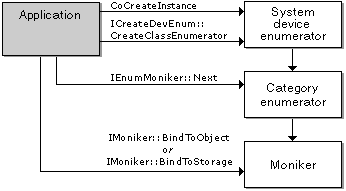
| Microsoft DirectX 8.1 (C++) |
The System Device Enumerator provides a uniform way to enumerate, by category, the filters registered on a user's system. Moreover, it differentiates between individual hardware devices, even if the same filter supports them. This is particularly useful for devices that use the Windows Driver Model (WDM) and the KSProxy filter. For example, the user might have several WDM video capture devices, all supported by the same filter. The System Device Enumerator treats them as separate device instances.
The System Device Enumerator works by creating an enumerator for a specific category, such as audio capture or video compression. The category enumerator returns a unique moniker for each device in the category. The category enumerator automatically includes any relevant Plug and Play devices in the category. For a list of categories, see Filter Categories.
To use the System Device Enumerator, do the following:
The following diagram illustrates this process.

The following example shows how to enumerate the video compressors installed on the user's system. For brevity, the example performs minimal error checking.
// Create the System Device Enumerator.
HRESULT hr;
ICreateDevEnum *pSysDevEnum = NULL;
hr = CoCreateInstance(CLSID_SystemDeviceEnum, NULL, CLSCTX_INPROC_SERVER,
IID_ICreateDevEnum, (void **)&pSysDevEnum);
// Obtain a class enumerator for the video compressor category.
IEnumMoniker *pEnumCat = NULL;
hr = pSysDevEnum->CreateClassEnumerator(CLSID_VideoCompressorCategory, &pEnumCat, 0);
if (hr == S_OK)
{
// Enumerate the monikers.
IMoniker *pMoniker;
ULONG cFetched;
while(pEnumCat->Next(1, &pMoniker, &cFetched) == S_OK)
{
IPropertyBag *pPropBag;
pMoniker->BindToStorage(0, 0, IID_IPropertyBag, (void **)&pPropBag);
// To retrieve the friendly name of the filter, do the following:
VARIANT varName;
VariantInit(&varName);
hr = pPropBag->Read(L"FriendlyName", &varName, 0);
if (SUCCEEDED(hr))
{
// Display the name in your UI somehow.
}
VariantClear(&varName);
// To create an instance of the filter, do the following:
IBaseFilter *pFilter;
pMoniker->BindToObject(NULL, NULL, IID_IBaseFilter, (void**)&pFilter);
// Now add the filter to the graph. Remember to release pFilter later.
// Clean up.
pPropBag->Release();
pMoniker->Release();
}
pEnumCat->Release();
}
pSysDevEnum->Release();
After calling BindToObject, call IFilterGraph::AddFilter to add the filter to the graph.